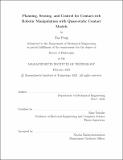Planning, Sensing, and Control for Contact-rich Robotic Manipulation with Quasi-static Contact Models
Author(s)
Pang, Tao
DownloadThesis PDF (31.47Mb)
Advisor
Tedrake, Russ
Terms of use
Metadata
Show full item recordAbstract
Human-level manipulation is not limited to the finger tips. We use our palms, arms, body and legs to make and break contact with the manipuland whenever and wherever necessary. In contrast, the vast majority of robotic manipulators are artificially divided into a small end effector that makes all the interactions, and a hefty arm that needs to always remain collision-free.
One big reason behind this unsatisfying limitation on robotic manipulators is the lack of planning algorithms that can efficiently reason about contact-rich interactions. Navigating the non-smooth landscape of contact dynamics constraints is perhaps the biggest challenge faced by model-based contact-rich planners. Existing methods either descend along the gradients of smoothed contact dynamics and get stuck in local minima, or search globally through contact mode transitions and get overwhelmed by the exponentially many modes as the problem gets more complex. Drawing lessons from the recent empirical success of reinforcement learning in contact-rich manipulation, we hypothesize that smoothing and global search are both necessary for contact-rich planners to succeed. In this thesis, we propose a model-based contact-rich planner which searches globally under the guidance of a novel contact dynamics model. The model is quasi-static, convex, differentiable and amenable to smoothing, all of which are features designed to improve the planner's efficiency. Our method can generate complex dexterous manipulation action plans with less than 1 minute of online computation on a regular desktop computer. The plans can also transfer directly to robotic hardware under certain conditions.
In addition to planning, a complete manipulation pipeline also needs contact force sensing and feedback control. Therefore, this thesis also studies the viability of estimating external contact forces from only joint torque measurements, and explores how to use feedback to keep the magnitude of contact forces bounded in an accidental collision.
Date issued
2023-02Department
Massachusetts Institute of Technology. Department of Mechanical EngineeringPublisher
Massachusetts Institute of Technology